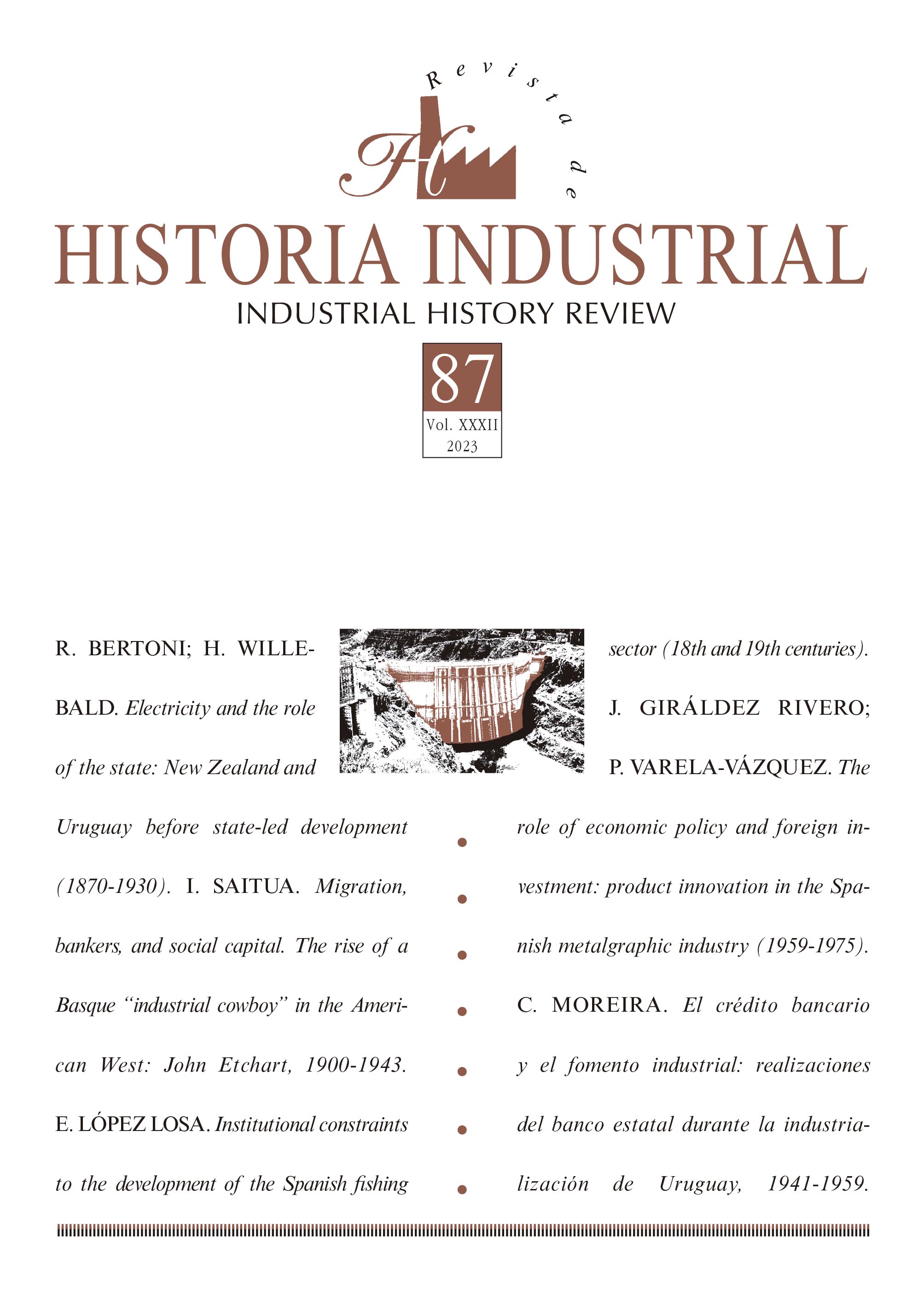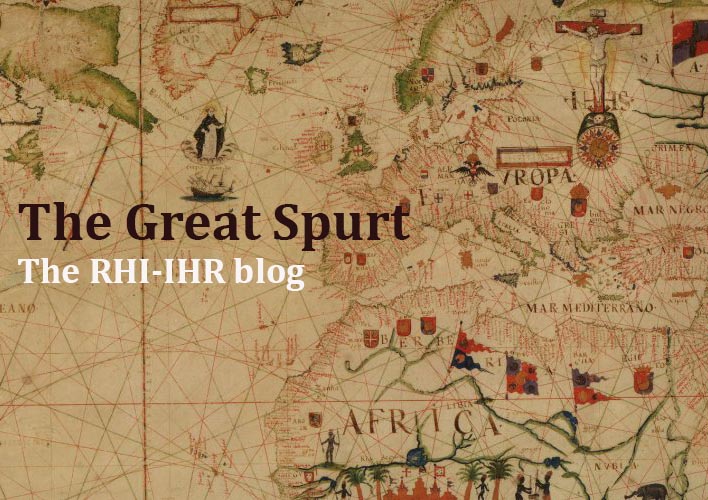Electricity and the role of the state: New Zealand and Uruguay before state-led development (1870-1930)
DOI:
https://doi.org/10.1344/rhiihr.37856Keywords:
settler economies, endogeneity of natural resources, role of state, electric system, electricity and developmentAbstract
The configuration of a “modern” production structure requires there to be sufficient en-ergy supply at competitive costs. Since the last third of the nineteenth century, coal produc-tion and better natural conditions for generating electric energy at low cost explain – at least partially – the differences in favour of New Zealand with respect to Uruguay. However, in-stitutional arrangements are another relevant factor of differentiation. Our argument is based on the concept of endogeneity of natural resources, and we use it to prove the differ-ent roles of states in electricity systems: state intervention aimed at improving welfare con-ditions in Uruguay without paying enough attention to aspects related to production condi-tions; while, in New Zealand, productive development was the focus of public action. As a result, a more extensive and denser electrical network was consolidated in New Zealand which, potentially, would have created better conditions in terms of diversification and ru-ral production.
Downloads
References
Acemoglu, Daron, Simon Johnson, and James A. Robinson. 2001. ‘The colonial originsof comparative development: an empirical investigation’, American Economic Review, 91 (5): 1369-1401.
Álvarez, Jorge. 2014. ‘Instituciones, cambio tecnológico y productividad en los sistemas agrarios de Nueva Zelanda y Uruguay. Patrones y trayectorias de largo plazo’. PhD thesis, Montevideo: Programa de Historia Económica y Social, Facultad de Ciencias Sociales, Universidad de la República, Uruguay (PHES-FCE-UdelaR).
Álvarez, Jorge, and Luis Bértola. 2013. ‘So Similar, So Different: New Zealand and Uruguay in the World Economy’. In Settler Economies in World History, edited by Christopher Lloyd, Jacob Metzer and Richard Sutch, 493-520. Netherlands: Brill.
Álvarez, Jorge, Ennio Bilancini, Simone D’Alessandro, and Gabriel Porc ile. 2011. ‘Agricultural Institutions, Industrialization and Growth: The Case of New Zealand and Uruguay in 1870–1940’, Explorations in Economic History, 48: 151-168.
Azar, Paola, Ulises Garc ia Repetto, Reto Bertoni, Claudia Sanguinetti, and Mariana Sienra. 2009. De quiénes, para quiénes y para qué. Las finanzas públicas en el Uruguay del Siglo XX. Montevideo: Fin de Siglo.
Bartolomé, Isabel, and Norma Lanciotti. 2015. ‘La electrificación en países de industrialización tardía: Argentina y España, 1890-1950’. Revista de Historia Industrial, 59, 24 (2): 81-113.
Bertoni, Reto. 2002. ‘Economía y cambio técnico: adopción y difusión de la energía eléctrica en Uruguay: 1880-1980’. Master’s thesis, Montevideo: Programa de Historia Económica y Social, Facultad de Ciencias Sociales, Universidad de la República, Uruguay (PHES-FCE-UdelaR).
Bertoni, Reto. 2011. Energía y Desarrollo. La restricción energética en Uruguay como problema. Montevideo: CSIC / Universidad de la República.
Bertoni, Reto, and Henry Willebald. 2016. ‘Do Natural Energy Endowments Matter? New Zealand and Uruguay in a Comparative Perspective, 1870-1940’. Australian Economic History Review, 56 (1): 70-99.
Betrán, Concepción. 2005. ‘Natural resources, electrification and economic growth from the end of the nineteenth century until World War II’. Revista de Historia Económica – Journal of Iberian and Latin American Economic History, 23 (1): 47-82.
Bjerkholt, Olav, Svein Longva, Øynstein Olsen, and Steinar Strom, eds. 1983. Analysis of Supply and Demand of Electricity in the Norwegian Economy. Oslo: Statistisk Sentralbyrå.
Bloomf ield, Gerald T. 1984. New Zealand: A handbook of historical statistics. Boston Massachusetts: GK Hall & Co.
Bolt, Jutta, Robert Inklaar, Herman De Jong, and Jan Luiten Van Zanden. 2018. ‘Rebasing “Maddison”: new income comparisons and the shape of long-run economic development’. Maddison Project Working Paper 10, Groningen: Groningen Growth and Development Centre.
Bonino, Nicolás, Antonio Tena-Junguito, and Henry Willebald. 2015. ‘Uruguay and the First Globalization. On the accuracy of export performance, 1870-1913’. Revista de Historia Económica - Journal of Iberian and Latin American Economic History, 33 (2): 287-320.
Brigg s, Phil. 2003. ‘Looking at the numbers: a view of New Zealand’s economic history’.
Research monograph (New Zealand Institute of Economic Research) 69, Wellington: NZ Institute of Economic Research.
Caetano, Gerardo. 1991/1992. La República Conservadora (1916-1929). 2 volumes, Montevideo: Editorial Fin de Siglo.
Cook, Megan. 2016. ‘Energy Supply and Use – Electricity, Late 19th to Mid-20th Century’. Te Ara - the Encyclopedia of New Zealand. http://www.TeAra.govt.nz/en/interactive/21443/expanding-network-1930 [accessed 13 September 2021].
Culy, John, Grant Read, and Brain Wrigh t. 1996. ‘The Evolution of New Zealand’s Electricity Supply Structure’. In International Comparisons of Electricity Regulation, edited by Richard J. Gilbert and Edward Kahn, 312-365. Cambridge, UK: Cambridge University Press.
Di Tella, Guido. 1982. ‘The Economics of the Frontier’. In Economic in the Long View, edited by Charles Kindleberger and Guido Di Tella, 210-227. London: Macmillan.
Ding, Ning, and Barry Field. 2004. ‘Natural Resource Abundance and Economic Growth’. Working Paper No. 2004-7. Massachusetts: University of Massachusetts Amherst, Department of Resource Economics. http://www.umass.edu/resec/workingpapers.
Dubash, Navroz. 2004. ‘Electric Power Reform: Social and Environmental Issues’. In Encyclopedia of Energy, edited by Cutler Cleveland, 255. Elsevier Science, Vol. 2.
Duncan, Bill. 2011. ‘An Overview of New Zealand’s Electricity System, 1908–1999’. IPENZ, http://www.ipenz.org.nz/heritage/itemdetail.cfm?itemid=2407 [Accessed 08/26/2017].
Energ ía. 1934a. ‘El desenvolvimiento de los servicios de la UTE en los 20 años que lleva de existencia’, Revista de la UTE, 1 (2): 1-72.
Energ ía. 1934b. ‘La electricidad aplicada a las industrias rurales’, Revista de la UTE, 1 (3).
Foreman-Peck, James. 1983. A History of the World Economy. International Economic Relations since 1850. Brighton, UK: Harvester Press.
Freeman, Christopher. 1989. ‘The Third Kondratieff Wave: Age of Steel, Electrification and Imperialism’. In Festschrift in Honour of Lars Herlitz, edited by Kihlstrom et al. Göteborg: Ed. Daidalos.
General Administration of Electric Power Plants of the State. Annual Reports. Several years.
General Administration of Power Plants and State Telephones (UTE) (July 1936). Journal of the UTE, 2.
Hausman, William, Peter Hertner, and Mirra Wilkins. 2008. Global Electrification. Multinational Enterprise and International Finance in the History of Light and Power, 1878–2007. Cambridge, NY: University Press.
Hjalmarsson, Lennart. 1996. ‘From club-regulation to market competition in the Scandinavian electricity supply industry’. In International Comparisons of Electricity Regulation, edited by Richard J. Gilbert and Edward Kahn, 129-178. Cambridge, UK: Cambridge University Press.
Lewis, William. 1983. Crecimiento y Fluctuaciones. Mexico: Fundación de Cultura Económica.
Lineham, Brent T. 1968. ‘New Zealand’s Gross Domestic Product, 1918/38’, New Zealand Economic Papers, 2: 15-26.
Martin, John. 1998. People, Politics and Power Stations. Electric Power Generation in New Zealand 1880-1998. Wellington: Electricity Corporation of New Zealand.
Maubr igades, Silvana. 2003. ‘Mercado de Cambios 1929-1975’, Serie Auxiliares de Investigación. Programa de Historia Económica y Social, Facultad de Ciencias Sociales, Universidad de la República, Uruguay.
McKinnon, Malcolm, ed. 1997. Bateman New Zealand historical atlas: ko papatuanuku e takoto nei. Auckland: David Bateman, plate 88.
Medina Vidal, Marcos. 1952. Reseña Histórica de la UTE. Montevideo. Ed. Medina.
Medlock, Kenneth. 2004. ‘Economics of Energy Demand’. In Encyclopedia of Energy, edited by Cutler Cleveland, 65-78. Elsevier Science.
Milburn, Josephine. 1960. ‘Socialism and Social Reform in Nineteenth-Century New Zealand’, Political Science 12 (1): 62-70.
Ministry for Culture and Heritage. New Zealand History, Research and Publishing Group of New Zealand (https://nzhistory.govt.nz).
Myllyntaus, Timo. 1994. ‘Electricity supply systems in the nordic countries’. In Electricity generation and supply: regulation, market and competition. International comparison, edited by Alain Beltran and Henri Morsel, 73-84, Eleventh International Economic History Congress. Milan: Universitá Bocconi.
Official Inform ation Center. National Register of Acts and Decr ees (several years). www.impo.gub.uy.
Ogilvie Buch anan, Robert. 1930. ‘Hydro-Electric Power Development in New Zealand’, The Geographical Journal, 75 (5): 444-457.
Oxman, Ramón. 1961. Energía, Consumo, Producción y Política Energética. Montevideo: Universidad de la República.
Newbery, David. 2001. Privatization, Restructuring and regulation of network industries. Cambridge MA: MIT Press.
Parr y, Evan. 1918. Hydro-electric development. Report by the Chief Electrical Engineer to the Honorable Sir W. Eraser, Minister of Public Works. Laid on the Table of the House of Representatives by Leave. https://teara.govt.nz/en/biographies/3p11/parry-evan.
Paulson, Ross. 1988. ‘Review: The Antipodeans Connection: New Zealand Liberalism and American Progressivism’, Review in American History, 16 (2): 272-277.
Perez, Carlota. 2009. ‘Technological revolutions and techno-economic paradigms’. Working Paper No. 20, Tallin: Norway and Tallinn University of Technology.
Perez, Carlota, and Luc Soete, L. 1988. ‘Catching up in technology: Entry barriers and windows of opportunity’. In Technical Change and Economic Theory, edited by Giovanni Dosi, Christopher Freeman, Richard Nelson, Gerard Silverberg and Luc Soete, 458-79. London / New York: Pinter
Román, Carolina, and Henry Willebald. 2021. ‘Structural change in a small natural resource intensive economy: Switching between diversification and re-primarization, Uruguay, 1870–2017’, Economic History of Developing Regions, 36 (1): 57-81.
Rozas, Patricio, and José Luis Bonifaz. 2014. ‘Notas sobre la teoría de la empresa pública de servicios de infraestructura y su regulación’. Serie Recursos Naturales e Infraestructura, No. 165. Santiago de Chile: CEPAL.
Saes, Alexander, and Norma Lanciotti. 2012. ‘La regulación de los servicios de electricidad en Argentina y Brasil (1890-1962)’, Economia e Sociedade, 21 (2): 409-447.
Stringleman, Hugh, and Frank Scr img eour. 2012. ‘Dairying and dairy products – Beginnings of New Zealand’s dairy industry’, Te Ara - the Encyclopedia of New Zealand. http://www.TeAra.govt.nz/en/dairying-and-dairy-products/page-1.
Swarbr ick, Nancy. 2016. ‘Rural services – Electricity’. Te Ara - the Encyclopedia of New Zealand. http://www.TeAra.govt.nz/en/rural-services/page-4.
Waiter, Andrea. 2020. ‘Capacidades de la ingeniería n acional y tomadores de decisiones: la construcción de la represa hidroeléctrica en Rincón del Bonete, Uruguay 1904-1945’, REDES, 26 (51).
Willebald, Henry. 2011. ‘Natural resources, settler economies and economic development during the First Globalization: land frontier expansion and institutional arrangements’. PhD dissertation in Economic History, Universidad Carlos III de Madrid, Departamento de Historia Económica e Instituciones, Getafe, http://hdl.handle.net/10016/12281.
Willebald, Henry. 2015. ‘Distributive Patterns in Settler Economies: Agrarian Income Inequality during the First Globalization (1870-1913)’, Historia Agraria. Revista de agricultura e historia rural, 66, 75-104.
Willebald, Henry, Marc Badía-Miró, and Vicente Pinilla. 2015. ‘Introduction: Natural Resources and Economic Development. What Can We Learn from History?’. In Natural Resources and Economic Growth: Learning from History, edited by Marc Badía-Miró, Vicente Pinilla and Henry Willebald, 21-45. London / New York: Routledge.
Williamson, Jeffrey. 2011. Trade and Poverty: When the Third World Fell Behind. Cambridge, MA: MIT Press.
Wrigh t, Gavin. 2015. ‘The USA as a case study in resource- based development’. In Natural Resources and Economic Growth: Learning from History, edited by Marc Badía-Miró, Vicente Pinilla and Henry Willebald, 119-139. London / New York: Routledge Explorations in Economic History, Taylor & Francis Group.
Wrigh t, Gavin, and Jesse Czelusta. 2007. ‘Resource-based Growth, Past and Present’. In Natural Resources: Neither Curse nor Destiny, edited by Daniel Lederman and William Maloney, 183-211. Stanford, CA: Stanford University Press.
Downloads
Published
How to Cite
Issue
Section
License
Copyright (c) 2022 Revista de Historia Industrial — Industrial History Review

This work is licensed under a Creative Commons Attribution 4.0 International License.
The author assigns all rights to the publisher. Creative Commons
The author who publishes in this journal agrees to the following terms:
- The author assigns all intellectual property rights exclusively to the publisher for the entire duration of the applicable intellectual property rights.
- The publisher will distribute the texts under the Creative Commons Attribution License, which allows others to share the work, provided that they acknowledge the authorship, its initial publication in this journal, and the conditions of the license.





